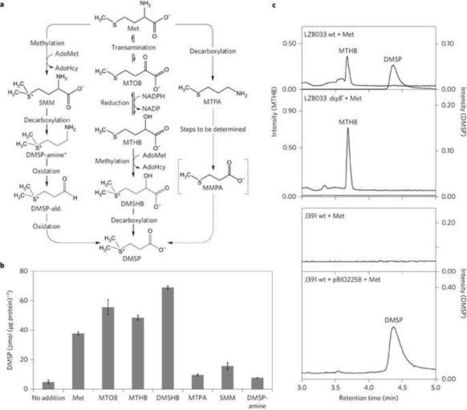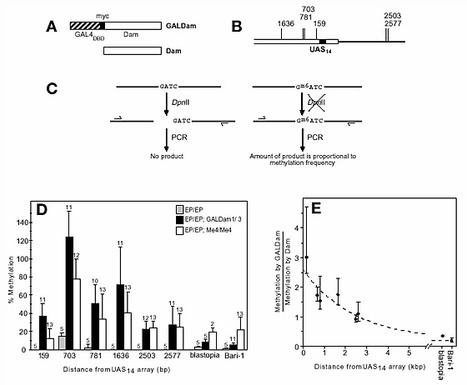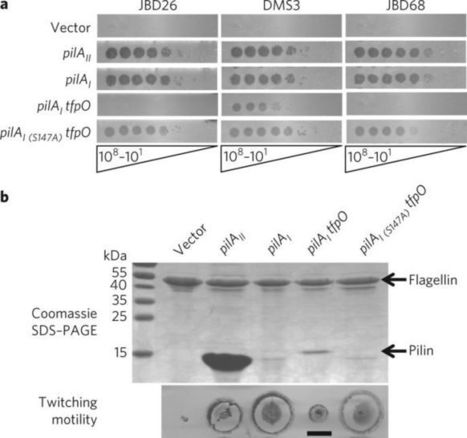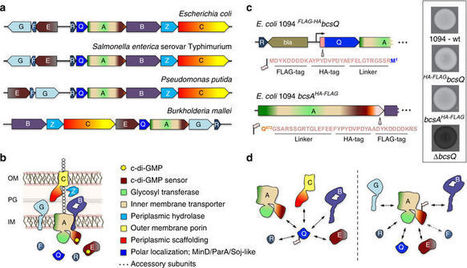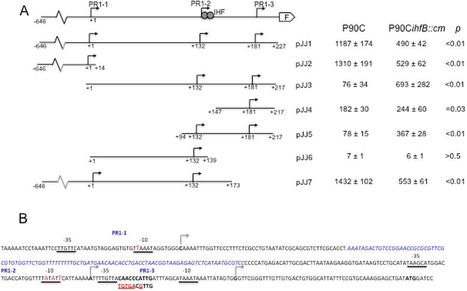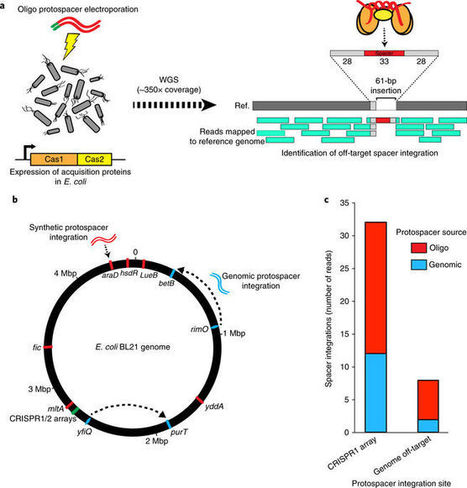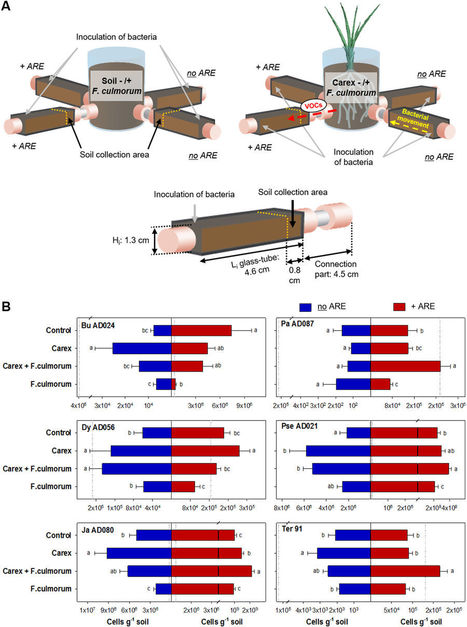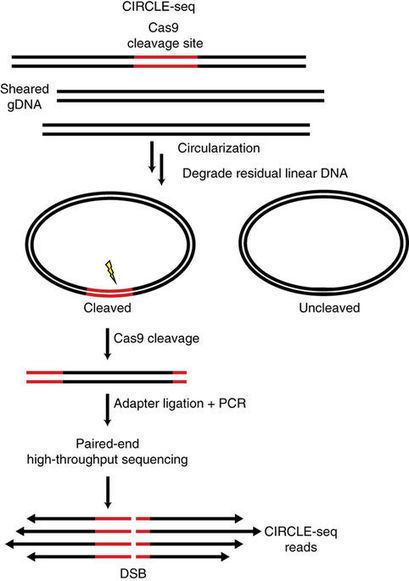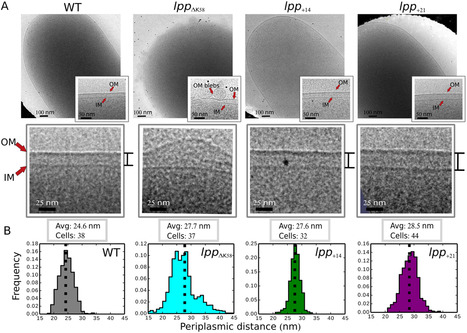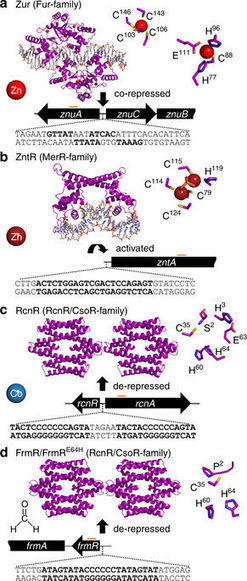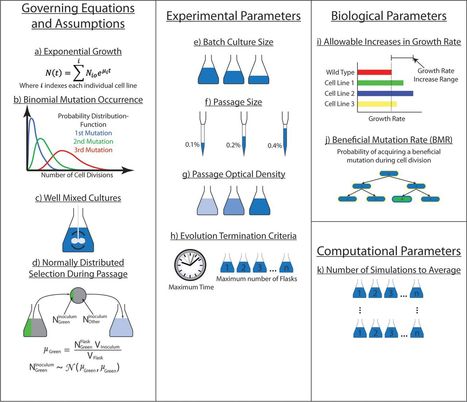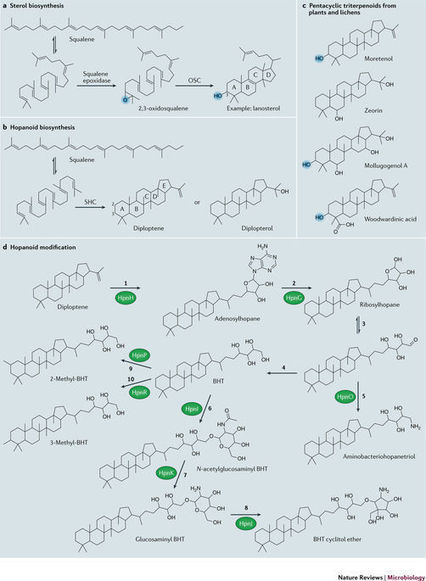 Your new post is loading...

|
Scooped by
?
February 28, 2018 9:18 AM
|
Dimethylsulfoniopropionate (DMSP) is one of the Earth's most abundant organosulfur molecules, a signalling molecule, a key nutrient for marine microorganisms and the major precursor for gaseous dimethyl sulfide (DMS). DMS, another infochemical in signalling pathways, is important in global sulfur cycling and affects the Earth's albedo, and potentially climate, via sulfate aerosol and cloud condensation nuclei production. It was thought that only eukaryotes produce significant amounts of DMSP, but here we demonstrate that many marine heterotrophic bacteria also produce DMSP, probably using the same methionine (Met) transamination pathway as macroalgae and phytoplankton. We identify the first DMSP synthesis gene in any organism, dsyB, which encodes the key methyltransferase enzyme of this pathway and is a reliable reporter for bacterial DMSP synthesis in marine Alphaproteobacteria. DMSP production and dsyB transcription are upregulated by increased salinity, nitrogen limitation and lower temperatures in our model DMSP-producing bacterium Labrenzia aggregata LZB033. With significant numbers of dsyB homologues in marine metagenomes, we propose that bacteria probably make a significant contribution to oceanic DMSP production. Furthermore, because DMSP production is not solely associated with obligate phototrophs, the process need not be confined to the photic zones of marine environments and, as such, may have been underestimated.

|
Scooped by
?
February 27, 2018 2:43 PM
|
We have developed a novel technique, named DamID, for the identification of DNA loci that interact in vivo with specific nuclear proteins in eukaryotes. By tethering Escherichia coli DNA adenine methyltransferase (Dam) to a chromatin protein, Dam can be targeted in vivo to native binding sites of this protein, resulting in local DNA methylation. Sites of methylation can subsequently be mapped using methylation-specific restriction enzymes or antibodies. We demonstrate the successful application of DamID both in Drosophila cell cultures and in whole flies. When Dam is tethered to the DNA-binding domain of GAL4, targeted methylation is limited to a region of a few kilobases surrounding a GAL4 binding sequence. Using DamID, we identified a number of expected and unexpected target loci for Drosophila heterochromatin protein 1. DamID has potential for genome-wide mapping of in vivo targets of chromatin proteins in various eukaryotes.

|
Scooped by
?
February 27, 2018 12:44 AM
|
Since phages present a major challenge to survival in most environments, bacteria express a battery of anti-phage defences including CRISPR–Cas, restriction-modification and abortive infection systems. Such strategies are effective, but the phage genome—which encodes potentially inhibitory gene products—is still allowed to enter the cell. The safest way to preclude phage infection is to block initial phage adsorption to the cell. Here, we describe a cell-surface modification that blocks infection by certain phages. Strains of the opportunistic pathogen Pseudomonas aeruginosa express one of five different type IV pilins (T4P), two of which are glycosylated with O-antigen units or polymers of D-arabinofuranose. We propose that predation by bacteriophages that use T4P as receptors selects for strains that mask potential phage binding sites using glycosylation. Here, we show that both modifications protect P. aeruginosa from certain pilus-specific phages. Alterations to pilin sequence can also block phage infection, but glycosylation is considered less likely to create disadvantageous phenotypes. Through construction of chimeric phages, we show that specific phage tail proteins allow for infection of strains with glycosylated pili. These studies provide insight into first-line bacterial defences against predation and ways in which phages circumvent them, and provide a rationale for the prevalence of pilus glycosylation in nature.

|
Scooped by
?
February 27, 2018 12:08 AM
|
Misinterpretation and abuse of statistical tests, confidence intervals, and statistical power have been decried for decades, yet remain rampant. A key problem is that there are no interpretations of these concepts that are at once simple, intuitive, correct, and foolproof. Instead, correct use and interpretation of these statistics requires an attention to detail which seems to tax the patience of working scientists. This high cognitive demand has led to an epidemic of shortcut definitions and interpretations that are simply wrong, sometimes disastrously so—and yet these misinterpretations dominate much of the scientific literature. In light of this problem, we provide definitions and a discussion of basic statistics that are more general and critical than typically found in traditional introductory expositions. Our goal is to provide a resource for instructors, researchers, and consumers of statistics whose knowledge of statistical theory and technique may be limited but who wish to avoid and spot misinterpretations. We emphasize how violation of often unstated analysis protocols (such as selecting analyses for presentation based on the P values they produce) can lead to small P values even if the declared test hypothesis is correct, and can lead to large P values even if that hypothesis is incorrect. We then provide an explanatory list of 25 misinterpretations of P values, confidence intervals, and power. We conclude with guidelines for improving statistical interpretation and reporting.

|
Scooped by
?
February 26, 2018 11:49 PM
|
Among the most important advances in microbiology during 2016 has to be the discovery of a major new class of peptidoglycan (PG) polymerases.

|
Scooped by
?
February 26, 2018 10:21 PM
|
Most studies of bacterial motility have examined small-scale (micrometer–centimeter) cell dispersal in monocultures. However, bacteria live in multispecies communities, where interactions with other microbes may inhibit or facilitate dispersal. Here, we demonstrate that motile bacteria in cheese rind microbiomes use physical networks created by filamentous fungi for dispersal, and that these interactions can shape microbial community structure. Serratia proteamaculans and other motile cheese rind bacteria disperse on fungal networks by swimming in the liquid layers formed on fungal hyphae. RNA-sequencing, transposon mutagenesis, and comparative genomics identify potential genetic mechanisms, including flagella-mediated motility, that control bacterial dispersal on hyphae. By manipulating fungal networks in experimental communities, we demonstrate that fungal-mediated bacterial dispersal can shift cheese rind microbiome composition by promoting the growth of motile over non-motile community members. Our single-cell to whole-community systems approach highlights the interactive dynamics of bacterial motility in multispecies microbiomes.

|
Scooped by
?
February 26, 2018 12:56 PM
|
Anthocyanins are a class of brightly colored, glycosylated flavonoid pigments that imbue their flower and fruit host tissues with hues of predominantly red, orange, purple, and blue. Although all anthocyanins exhibit pH-responsive photochemical changes, distinct structural decorations on the core anthocyanin skeleton also cause dramatic color shifts, in addition to improved stabilities and unique pharmacological properties. In this work, we report for the first time the extension of the reconstituted plant anthocyanin pathway from (+)-catechin to O-methylated anthocyanins in a microbial production system, an effort which requires simultaneous co-option of the endogenous metabolites UDP-glucose and S-adenosyl-l-methionine (SAM or AdoMet). Anthocyanin O-methyltransferase (AOMT) orthologs from various plant sources were co-expressed in Escherichia coli with Petunia hybrida anthocyanidin synthase (PhANS) and Arabidopsis thaliana anthocyanidin 3-O-glucosyltransferase (At3GT). Vitis vinifera AOMT (VvAOMT1) and fragrant cyclamen ‘Kaori-no-mai’ AOMT (CkmOMT2) were found to be the most effective AOMTs for production of the 3′-O-methylated product peonidin 3-O-glucoside (P3G), attaining the highest titers at 2.4 and 2.7 mg/L, respectively. Following modulation of plasmid copy number and optimization of VvAOMT1 and CkmOMT2 expression conditions, production was further improved to 23 mg/L using VvAOMT1. Finally, CRISPRi was utilized to silence the transcriptional repressor MetJ in order to deregulate the methionine biosynthetic pathway and improve SAM availability for O-methylation of cyanidin 3-O-glucoside (C3G), the biosynthetic precursor to P3G. MetJ repression led to a final titer of 51 mg/L (56 mg/L upon scale-up to shake flask), representing a twofold improvement over the non-targeting CRISPRi control strain and 21-fold improvement overall. An E. coli strain was engineered for production of the specialty anthocyanin P3G using the abundant and comparatively inexpensive flavonol precursor, (+)-catechin. Furthermore, dCas9-mediated transcriptional repression of metJ alleviated a limiting SAM pool size, enhancing titers of the methylated anthocyanin product. While microbial production of P3G and other O-methylated anthocyanin pigments will likely be valuable to the food industry as natural food and beverage colorants, we expect that the strain constructed here will also prove useful to the ornamental plant industry as a platform for evaluating putative anthocyanin O-methyltransferases in pursuit of bespoke flower pigment compositions.

|
Scooped by
?
February 26, 2018 2:03 AM
|
Secreted exopolysaccharides present important determinants for bacterial biofilm formation, survival, and virulence. Cellulose secretion typically requires the concerted action of a c-di-GMP-responsive inner membrane synthase (BcsA), an accessory membrane-anchored protein (BcsB), and several additional Bcs components. Although the BcsAB catalytic duo has been studied in great detail, its interplay with co-expressed subunits remains enigmatic. Here we show that E. coli Bcs proteins partake in a complex protein interaction network. Electron microscopy reveals a stable, megadalton-sized macromolecular assembly, which encompasses most of the inner membrane and cytosolic Bcs components and features a previously unobserved asymmetric architecture. Heterologous reconstitution and mutational analyses point toward a structure–function model, where accessory proteins regulate secretion by affecting both the assembly and stability of the system. Altogether, these results lay the foundation for more comprehensive models of synthase-dependent exopolysaccharide secretion in biofilms and add a sophisticated secretory nanomachine to the diverse bacterial arsenal for virulence and adaptation.

|
Scooped by
?
February 26, 2018 12:59 AM
|
In this study we characterise three tandem promoters (PR1-1, PR1-2 and PR1-3) within the PR1 regulatory region of the Escherichia coli kps capsule gene cluster. Transcription from promoter PR1-2 was dependent on the activity of the upstream promoter PR1-1, which activated PR1-2 via transcription coupled DNA supercoiling. During growth at 37 °C a temporal pattern of transcription from all three promoters was observed with maximum transcriptional activity evident during mid-exponential phase followed by a sharp decrease in activity as the cells enter stationary phase. The growth phase dependent transcription was regulated by Integration Host Factor (IHF), which bound within the PR1 region to repress transcription from PR1-2 and PR1-3. This pattern of transcription was mirrored by growth phase dependent expression of the K1 capsule. Overall these data reveal a complex pattern of transcriptional regulation for an important virulence factor with IHF playing a role in regulating growth phase expression.

|
Scooped by
?
February 23, 2018 6:15 PM
|
The adaptation phase of CRISPR–Cas immunity depends on the precise integration of short segments of foreign DNA (spacers) into a specific genomic location within the CRISPR locus by the Cas1–Cas2 integration complex. Although off-target spacer integration outside of canonical CRISPR arrays has been described in vitro, no evidence of non-specific integration activity has been found in vivo. Here, we show that non-canonical off-target integrations can occur within bacterial chromosomes at locations that resemble the native CRISPR locus by characterizing hundreds of off-target integration locations within Escherichia coli. Considering whether such promiscuous Cas1–Cas2 activity could have an evolutionary role through the genesis of neo-CRISPR loci, we combed existing CRISPR databases and available genomes for evidence of off-target integration activity. This search uncovered several putative instances of naturally occurring off-target spacer integration events within the genomes of Yersinia pestis and Sulfolobus islandicus. These results are important in understanding alternative routes to CRISPR array genesis and evolution, as well as in the use of spacer acquisition in technological applications.

|
Scooped by
?
February 23, 2018 5:33 PM
|
Plants release a wide set of secondary metabolites including volatile organic compounds (VOCs). Many of those compounds are considered to function as defense against herbivory, pests, and pathogens. However, little knowledge exists about the role of belowground plant VOCs for attracting beneficial soil microorganisms. We developed an olfactometer system to test the attraction of soil bacteria by VOCs emitted by Carex arenaria roots. Moreover, we tested whether infection of C. arenaria with the fungal pathogen Fusarium culmorum modifies the VOCs profile and bacterial attraction. The results revealed that migration of distant bacteria in soil towards roots can be stimulated by plant VOCs. Upon fungal infection, the blend of root VOCs changed and specific bacteria with antifungal properties were attracted. Tests with various pure VOCs indicated that those compounds can diffuse over long distance but with different diffusion abilities. Overall, this work highlights the importance of plant VOCs in belowground long-distance plant–microbe interactions.

|
Scooped by
?
February 23, 2018 5:10 PM
|
Fungi and bacteria are found living together in a wide variety of environments. Their interactions are significant drivers of many ecosystem functions and are important for the health of plants and animals. A large number of fungal and bacterial families are engaged in complex interactions that lead to critical behavioural shifts of the microorganisms ranging from mutualism to pathogenicity. The importance of bacterial-fungal interactions (BFI) in environmental science, medicine and biotechnology has led to the emergence of a dynamic and multidisciplinary research field that combines highly diverse approaches including molecular biology, genomics, geochemistry, chemical and microbial ecology, biophysics and ecological modelling. In this review, we discuss most recent advances that underscore the roles of BFI across relevant habitats and ecosystems. A particular focus is placed on the understanding of BFI within complex microbial communities and in regards of the metaorganism concept. We also discuss recent discoveries that clarify the (molecular) mechanisms involved in bacterial-fungal relationships, and the contribution of new technologies to decipher generic principles of BFI in terms of physical associations and molecular dialogues. Finally, we discuss future directions for researches in order to catalyse a synergy within the BFI research area and to resolve outstanding questions.

|
Scooped by
?
February 23, 2018 4:42 PM
|
|

|
Scooped by
?
February 27, 2018 4:40 PM
|
Sensitive detection of off-target effects is important for translating CRISPR–Cas9 nucleases into human therapeutics. In vitro biochemical methods for finding off-targets offer the potential advantages of greater reproducibility and scalability while avoiding limitations associated with strategies that require the culture and manipulation of living cells. Here we describe circularization for in vitro reporting of cleavage effects by sequencing (CIRCLE-seq), a highly sensitive, sequencing-efficient in vitro screening strategy that outperforms existing cell-based or biochemical approaches for identifying CRISPR–Cas9 genome-wide off-target mutations. In contrast to previously described in vitro methods, we show that CIRCLE-seq can be practiced using widely accessible next-generation sequencing technology and does not require reference genome sequences. Importantly, CIRCLE-seq can be used to identify off-target mutations associated with cell-type-specific single-nucleotide polymorphisms, demonstrating the feasibility and importance of generating personalized specificity profiles. CIRCLE-seq provides an accessible, rapid, and comprehensive method for identifying genome-wide off-target mutations of CRISPR–Cas9.

|
Scooped by
?
February 27, 2018 8:33 AM
|
The degree to which an organism can affect its associated microbial communities ("microbiome") varies by organism and habitat, and in many cases is unknown. We address this question by analyzing the metabolically active bacteria of the maize phyllosphere across 300 diverse maize lines growing in a common environment. We performed comprehensive heritability analysis for 49 community diversity metrics, 380 bacterial clades (individual operational taxonomic units and higher-level groupings), and 9042 predicted metagenomic functions. We find that only a few few bacterial clades (5) and diversity metrics (2) are significantly heritable, while a much larger number of metabolic functions (200) are. Many of these associations appear to be driven by the amount of Methylobacteria present in each sample, and we find significant enrichment for traits relating to short-chain carbon metabolism, secretion, and nitrotoluene degradation. Genome-wide association analysis identifies a small number of associated loci for these heritable traits, including two loci (on maize chromosomes 7 and 10) that affect a large number of traits even after correcting for correlations among traits. This work is among the most comprehensive analyses of the maize phyllosphere to date. Our results indicate that while most of the maize phyllosphere composition is driven by environmental factors and/or stochastic founder events, a subset of bacterial taxa and metabolic functions is nonetheless significantly impacted by host plant genetics. Additional work will be needed to identify the exact nature of these interactions and what effects they may have on the phenotype of host plants.

|
Scooped by
?
February 27, 2018 12:19 AM
|
The cell envelope of gram-negative bacteria, a structure comprising an outer (OM) and an inner (IM) membrane, is essential for life. The OM and the IM are separated by the periplasm, a compartment that contains the peptidoglycan. The OM is tethered to the peptidoglycan via the lipoprotein, Lpp. However, the importance of the envelope’s multilayered architecture remains unknown. Here, when we removed physical coupling between the OM and the peptidoglycan, cells lost the ability to sense defects in envelope integrity. Further experiments revealed that the critical parameter for the transmission of stress signals from the envelope to the cytoplasm, where cellular behaviour is controlled, is the IM-to-OM distance. Augmenting this distance by increasing the length of the lipoprotein Lpp destroyed signalling, whereas simultaneously increasing the length of the stress-sensing lipoprotein RcsF restored signalling. Our results demonstrate the physiological importance of the size of the periplasm. They also reveal that strict control over the IM-to-OM distance is required for effective envelope surveillance and protection, suggesting that cellular architecture and the structure of transenvelope protein complexes have been evolutionarily co-optimised for correct function. Similar strategies are likely at play in cellular compartments surrounded by 2 concentric membranes, such as chloroplasts and mitochondria.

|
Scooped by
?
February 26, 2018 11:53 PM
|
Bacteria possess transcription factors whose DNA-binding activity is altered upon binding to specific metals, but metal binding is not specific in vitro. Here we show that tight regulation of buffered intracellular metal concentrations is a prerequisite for metal specificity of Zur, ZntR, RcnR and FrmR in Salmonella Typhimurium. In cells, at non-inhibitory elevated concentrations, Zur and ZntR, only respond to Zn(II), RcnR to cobalt and FrmR to formaldehyde. However, in vitro all these sensors bind non-cognate metals, which alters DNA binding. We model the responses of these sensors to intracellular-buffered concentrations of Co(II) and Zn(II) based upon determined abundances, metal affinities and DNA affinities of each apo- and metalated sensor. The cognate sensors are modelled to respond at the lowest concentrations of their cognate metal, explaining specificity. However, other sensors are modelled to respond at concentrations only slightly higher, and cobalt or Zn(II) shock triggers mal-responses that match these predictions. Thus, perfect metal specificity is fine-tuned to a narrow range of buffered intracellular metal concentrations.

|
Scooped by
?
February 26, 2018 11:39 PM
|
Plant RuBisCo, a complex of eight large and eight small subunits, catalyzes the fixation of CO2 in photosynthesis. The low catalytic efficiency of RuBisCo provides strong motivation to reengineer the enzyme with the goal of increasing crop yields. However, genetic manipulation has been hampered by the failure to express plant RuBisCo in a bacterial host. We achieved the functional expression of Arabidopsis thaliana RuBisCo in Escherichia coli by coexpressing multiple chloroplast chaperones. These include the chaperonins Cpn60/Cpn20, RuBisCo accumulation factors 1 and 2, RbcX, and bundle-sheath defective-2 (BSD2). Our structural and functional analysis revealed the role of BSD2 in stabilizing an end-state assembly intermediate of eight RuBisCo large subunits until the small subunits become available. The ability to produce plant RuBisCo recombinantly will facilitate efforts to improve the enzyme through mutagenesis.

|
Scooped by
?
February 26, 2018 5:50 PM
|
Rhizobium sp. IRBG74 not only nodulates Sesbania cannabina but also can enhance rice growth; however, the underlying molecular mechanisms are not clear. Here, we show that Rhizobium sp. IRBG74 colonizes the roots of Arabidopsis thaliana, which leads to inhibition in the growth of main root but enhancement in the formation of lateral roots. The promotion of lateral root formation by Rhizobium sp. IRBG74 in the fls2-1 mutant, which is insensitive to flagellin, is similar to the wild-type plant, while the auxin response deficient mutant tir1-1 is significantly less sensitive to Rhizobium sp. IRBG74 than the wild type in terms of the inhibition of main root elongation and the promotion of lateral root formation. Further transcriptome analysis of Arabidopsis roots inoculated with Rhizobium sp. IRBG74 revealed differential expression of 50 and 211 genes at 24 and 48 h, respectively, and a majority of these genes are involved in auxin signaling. Consistent with the transcriptome analysis results, Rhizobium sp. IRBG74 treatment induces expression of the auxin responsive reporter DR5:GUS in roots. Our results suggest that in Arabidopsis Rhizobium sp. IRBG74 colonizes roots and promotes the lateral root formation likely through modulating auxin signaling. Our work provides insight into the molecular mechanisms of interactions between legume-nodulating rhizobia and non-legume plants.

|
Scooped by
?
February 26, 2018 10:25 AM
|
The occurrence of mutations is a cornerstone of the evolutionary theory of adaptation, capitalizing on the rare chance that a mutation confers a fitness benefit. Natural selection is increasingly being leveraged in laboratory settings for industrial and basic science applications. Despite increasing deployment, there are no standardized procedures available for designing and performing adaptive laboratory evolution (ALE) experiments. Thus, there is a need to optimize the experimental design, specifically for determining when to consider an experiment complete and for balancing outcomes with available resources (i.e., laboratory supplies, personnel, and time). To design and to better understand ALE experiments, a simulator, ALEsim, was developed, validated, and applied to the optimization of ALE experiments. The effects of various passage sizes were experimentally determined and subsequently evaluated with ALEsim, to explain differences in experimental outcomes. Furthermore, a beneficial mutation rate of 10−6.9 to 10−8.4 mutations per cell division was derived. A retrospective analysis of ALE experiments revealed that passage sizes typically employed in serial passage batch culture ALE experiments led to inefficient production and fixation of beneficial mutations. ALEsim and the results described here will aid in the design of ALE experiments to fit the exact needs of a project while taking into account the resources required and will lower the barriers to entry for this experimental technique.

|
Scooped by
?
February 26, 2018 1:49 AM
|
Quorum sensing (QS) is a cell–cell communication process that enables bacteria to track cell population density and orchestrate collective behaviors. QS relies on the production and detection of, and the response to, extracellular signal molecules called autoinducers. In Vibrio cholerae, multiple QS circuits control pathogenesis and biofilm formation. Here, we identify and characterize a new QS autoinducer–receptor pair. The autoinducer is 3,5-dimethylpyrazin-2-ol (DPO). DPO is made from threonine and alanine, and its synthesis depends on threonine dehydrogenase (Tdh). DPO binds to and activates a transcription factor, VqmA. The VqmA–DPO complex activates expression of vqmR, which encodes a small regulatory RNA. VqmR represses genes required for biofilm formation and toxin production. We propose that DPO allows V. cholerae to regulate collective behaviors to, among other possible roles, diversify its QS output during colonization of the human host.

|
Scooped by
?
February 25, 2018 12:34 PM
|
Under iron limitation, bacteria scavenge ferric (Fe3+) iron bound to siderophores or other chelates from the environment to fulfill their nutritional requirement. In gram-negative bacteria, the siderophore uptake system prototype consists of an outer membrane transporter, a periplasmic binding protein and a cytoplasmic membrane transporter, each specific for a single ferric siderophore or siderophore family. Here, we show that spontaneous single gain-of-function missense mutations in outer membrane transporter genes of Bradyrhizobium japonicum were sufficient to confer on cells the ability to use synthetic or natural iron siderophores, suggesting that selectivity is limited primarily to the outer membrane and can be readily modified. Moreover, growth on natural or synthetic chelators required the cytoplasmic membrane ferrous (Fe2+) iron transporter FeoB, suggesting that iron is both dissociated from the chelate and reduced to the ferrous form within the periplasm prior to cytoplasmic entry. The data suggest rapid adaptation to environmental iron by facile mutation of selective outer membrane transporter genes and by non-selective uptake components that do not require mutation to accommodate new iron sources.

|
Scooped by
?
February 23, 2018 6:12 PM
|
Actinobacteria is a phylum of gram-positive bacteria, and members of bacteria belonging to this phylum are classified into six classes, namely Acidimicrobiia, Actinobacteria, Coriobacteriia, Nitriliruptoria, Rubrobacteria, and Thermoleophilia. Among the six different classes, members of the actinobacteria class are the most dominant and contain one of the largest genera, Streptomyces, with 961 distinct species. Members of phylum actinobacteria are ubiquitous in nature and have been isolated from various extreme environments (high temperatures, pH, salinities, pressure, and drought) and are associated with plants growing in different habitats. The rhizospheric actinobacteria are the most dominant in nature and they are of great economic importance to humans due to their huge contributions to soil systems. Based on a comprehensive literature analysis members of phylum actinobacteria have been reported from different genera such as Acidimicrobium, Actinomyces, Arthrobacter, Bifidobacterium, Cellulomonas, Clavibacter, Corynebacterium, Frankia, Microbacterium, Micrococcus, Mycobacterium, Nocardia, Propionibacterium, Pseudonocardia, Rhodococcus, Sanguibacter, and Streptomyces. Actinobacteria can be utilized as bioinoculants for sustainable agriculture as they can enhance plant growth and yield both by directly promoting plant growth by the fixation of atmospheric nitrogen, the solubilization of minerals such as phosphorus, potassium, and zinc, the production of siderophores and plant growth hormones such cytokinin, auxin, and gibberellins, and by indirect plant growth promotion via production of antagonistic substances by inducing resistance against plant pathogens. The actinobacteria has been proved to have immense importance in biotechnological applications in various industrial and agricultural processes that are discussed in this chapter.

|
Scooped by
?
February 23, 2018 5:28 PM
|
Hopanoids, which resemble sterols and are found in the membranes of diverse bacteria, have left an extensive molecular fossil record. Today, hopanoid-producing bacteria remain abundant in various ecosystems, such as the rhizosphere. In vitro, hopanoids contribute to bacterial stress resistance, which may help explain their ability to facilitate beneficial plant–bacteria interactions. However, given that hopanoids can also serve as carriers for plant hormones and that plants themselves make hopanoid-like compounds, it is likely that other mechanisms are additionally at play. In closing, we remind the reader of the words of John F. Kennedy when explaining what was needed to send astronauts to the Moon. “We choose to go to the Moon! ... We choose to go to the Moon in this decade and do the other things, not because they are easy, but because they are hard; because that goal will serve to organize and measure the best of our energies and skills...”. Replacing the words 'go to the Moon' with 'study lipids' provides fitting inspiration for tackling one of the next great challenges in microbiology. It is time for lipids to get the attention they deserve, and the study of hopanoids is an excellent place to begin.

|
Scooped by
?
February 23, 2018 4:53 PM
|
Four nucleotide bases carry all the information an organism needs to live and function. Can this limited set of bases be expanded to carry more information? Now, a new study by Floyd Romesberg at The Scripps Research Institute reports that introducing unnatural nucleotides into DNA results in the incorporation of novel amino acids into proteins in E.coli. While other research groups have engineered cells to incorporate unnatural amino acids into cellular proteins, Romesberg focused on expanding the information stored in DNAso that semi-synthetic organisms could create new proteins and perform unnatural functions. “The natural system was there, and I wanted to augment the natural system,” said Romesberg.
|






 Your new post is loading...
Your new post is loading...
